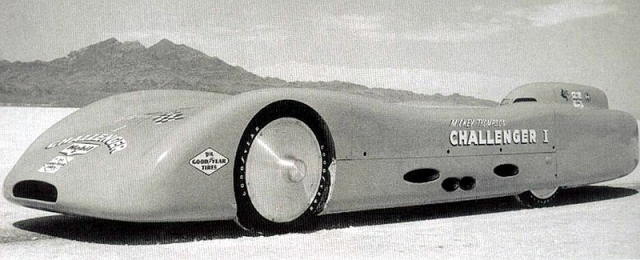 Mickey Thompson is a name synonymous with gigantic drag slicks and massive off road tires. However, before he became the performance tire king, Thompson built a larger than life legacy. A legacy that he built around numerous innovations in hot rodding, and records he forever scribed into history books. Danny Thompson, Mickey’s son, has followed in his father’s foot steps and has taken it upon himself to tell the stories of his father’s legacy.
Mickey Thompson is a name synonymous with gigantic drag slicks and massive off road tires. However, before he became the performance tire king, Thompson built a larger than life legacy. A legacy that he built around numerous innovations in hot rodding, and records he forever scribed into history books. Danny Thompson, Mickey’s son, has followed in his father’s foot steps and has taken it upon himself to tell the stories of his father’s legacy.
In 1954, drag racing was young and it was dominated by T-buckets, deuces & family sedans. While these cars were fast, Thompson wanted to build a faster car that would push the envelope and reach new velocities. To achieve this, he built his own car from scratch, his design was that of a long wheel base railjob with a one seat cockpit.
He needed traction for more speed, so he approached the A1 tire company and they constructed massive rear tires: the first drag slicks. His slingshot was faster than any other car on the strip when it debuted. Its unique design and unmatched performance inspired other hot rodders to build dragsters of their own, leading to the creation of Top Fuel drag racing.
Mickey and his Slingshot
In 1952 Mickey caught the Bonneville bug and became fascinated with land speed racing. He wanted to set records on the salt flats, so he built his own streamliner and on his first time out he reached a speed of 194 MPH. In 1958 he met up with a buddy named Fritz Foyd who shared his dream of speed. They built a custom streamliner out of scratch, spending $8,000 on junkyard parts. When they attended Bonneville they had the fastest car that weekend with a speed of 294 MPH.
After gaining experience, Thompson’s next goal was to beat the British record of 394.19 MPH which was set by John Cobb in 1947. He wanted to not only break this record but crush it by reaching a speed of 400 MPH. Thompson and Foyd purchased four junkyard fuel injected Pontiac 415 engines that were mated to four 37 Cadillac trannys. They fabricated a car which could house these four massive V-8s, a long sleek streamliner nicknamed Challenger.
In 1959 the duo took Challenger to Bonneville and reached a speed of 363 MPH, just below Cobbs record and their 400 MPH goal. They spent the next year making improvements such as adding four superchargers, which gave each engine 750 hp. In 1960 Thompson piloted the car to astonishing 406 MPH at Bonneville making him the fastest man on Earth. His colossal feat would inspire the American speed wars of the ’60s leading to the quest for 500 & 600 MPH by Craig Breedlove, Art Arfons and Walt Arfons.
In 1962 the Indy 500 was a whole different ball game compared to today. The cars were largely custom built by their race teams, most cars were front engined and there were few rules. Mickey built his own car that was ahead of the times; it was rear engined, rear winged and was built around a titanium frame.
While most of the other cars weighed around 2000 pounds, Thompson’s car only weighed 800. USAC and many of the other Indy racers weren’t happy that this California hot rodder built a superior machine. This led USAC to change the rules requiring that his car had to weigh over 2000 lbs.
While in the pits, he had quickly increased the weight of a car – which was designed to be light. This change caused it to not perform as well as it should have, despite that change, Thompson’s driver, Dan Gurney, still qualified 8th.
In 1979, Thompson wanted to bring the excitement of off road racing to the masses. He needed a venue where an off road race could be run and the entire race could be seen by the whole crowd. The venue: the LA Coliseum. He took 25 million pounds of dirt, compacted it into the stadium, and designed his own little piece of Baja.
The Coliseum was packed and people were blown away by the action packed racing. Eventually Stadium off road races were taking place across the country. The legacy continues today under the Robby Gordon Stadium Super Trucks.
Thompson first visited the Salt Flats when he was only 7 years old. At the time Land Speed Racing was new and unknown, but he knew that this white desert was the place where his dreams would come alive.
His legacy has inspired countless other hot rodders to push the envelope even further and take his innovations to a new level. Mickey Thompson was a man of vision and the ultimate pioneer of speed.























